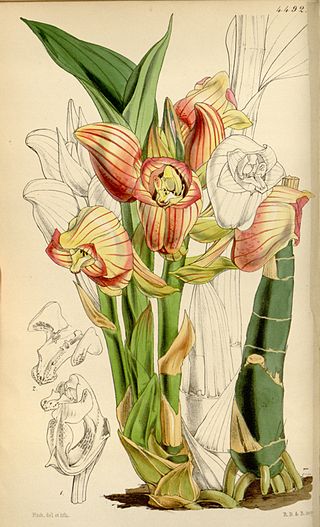
Acanthophippium is a genus of orchid with thirteen species. The name of this genus is derived from the Greek words acanthos ("spiny") and ephippion ("saddle"), referring to the saddle-like labellum of the plants.

Charles Ludwig de Blume or Karl Ludwig von Blume was a German-Dutch botanist. The standard author abbreviation Blume is used to indicate this person as the author when citing a botanical name.
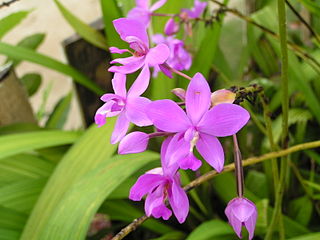
Spathoglottis, commonly known as purple orchids or 苞舌兰属 is a genus of about fifty species of orchids in the family Orchidaceae. They are evergreen terrestrial herbs with crowded pseudobulbs, a small number of leaves and medium-sized resupinate flowers on an upright flowering stem. The sepals and petals are all similar to each other and are white, yellow, pink or purple. Species of Spathoglottis are found from eastern and south-eastern Asia to Australia and some Pacific Islands.
Cheilosa is a monotypic plant genus of the family Euphorbiaceae first described as a genus in 1826. Only one species is recognized: Cheilosa montana, native to Southeast Asia.
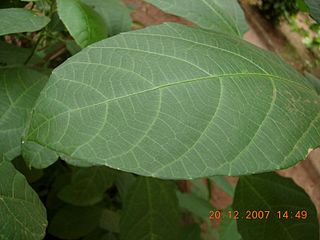
Baliospermum is a genus of plants under the family Euphorbiaceae first described as a genus in 1825. It is native to Southeast Asia and the Himalayas.
Ostodes is a genus of plants under the family Euphorbiaceae first described as a genus in 1826. It is native to southern China, the Himalayas, and parts of Southeast Asia.
- Ostodes kuangiiY.T.Chang - Yunnan
- Ostodes paniculataBlume - Hainan, Yunnan, Tibet, Nepal, Sikkim, Bhutan, N Bangladesh, Assam, Thailand, Myanmar, W Malaysia, Borneo, Java, Sumatra

Bischofia is a genus of plants in the family Phyllanthaceae first described as a genus in 1827. It is native to southern China, the Indian Subcontinent, Queensland, New Guinea, and various islands of the Pacific. It is the only member of the tribe Bischofieae. They are dioecious, with male and female flowers on separate plants, but may rarely be monoecious.

Apostasia, commonly known as grass orchids, is a genus of eight species of primitive orchids in the family Orchidaceae. They are terrestrial, evergreen, grass-like plants, barely recognisable as orchids and are distributed in humid areas of the Himalayan region, China, India, Sri Lanka, Southeast Asia, New Guinea, and Queensland. They have many narrow leaves and small yellow or white, non-resupinate, star-like flowers usually arranged on a branched flowering stem.
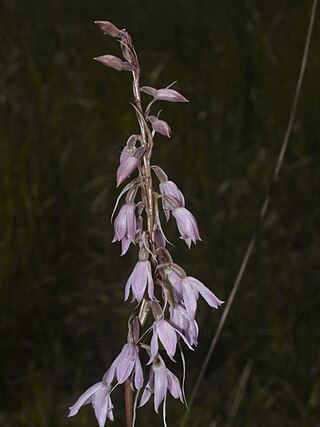
Pachystoma, commonly known as kunai orchids or 粉口兰属 , is a genus of two species of flowering plants in the orchid family, Orchidaceae. They are deciduous, terrestrial herbs with one or two linear, pleated or veiny leaves and more or less drooping flowers which do not open widely, on a thin, wiry flowering stem. Species in this genus are found in tropical and subtropical Asia to Australia and islands of the southwest Pacific Ocean.
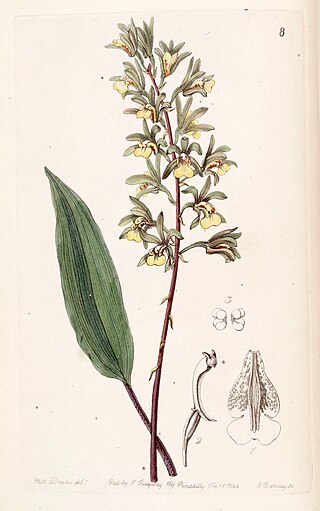
Tainia, commonly known as ribbon orchids or 带唇兰属 is a genus of about thirty species of evergreen, terrestrial orchids in the distributed from India, China, Japan, Southeast Asia to New Guinea, the Solomon Islands and Queensland.
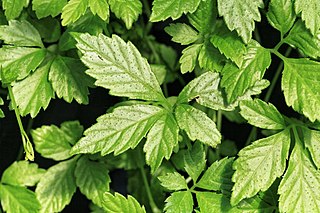
Gynostemma pentaphyllum, also called jiaogulan, is a dioecious, herbaceous climbing vine of the family Cucurbitaceae widely distributed in South and East Asia as well as New Guinea. Jiaogulan has recently been incorporated into traditional medicine.

Daphniphyllum is the sole genus in the flowering plant family Daphniphyllaceae and was described as a genus in 1826. The genus includes evergreen shrubs and trees mainly native to east and southeast Asia, but also found in the Indian Subcontinent and New Guinea.

Maranthes is a genus of plant in the family Chrysobalanaceae described as a genus in 1825.

Crepidium, commonly known as 沼兰属 or spur orchids is a genus of about three hundred species of orchids in the family Orchidaceae. Plants in this genus are evergreen, mostly terrestrial plants with short stems lying on the ground, two or more relatively large, pleated leaves and small, non-resupinate flowers with spreading sepals and petals. The genus is widely distributed in the tropics.

Phyllocephalum is a genus of Asian flowering plants in the tribe Vernonieae within the family Asteraceae.

Cheirostylis, commonly known as fleshy jewel orchids or velvet orchids, is a genus of about sixty species of flowering plants in the orchid family Orchidaceae. Plants in this genus are terrestrial herbs with a caterpillar-like rhizome and a loose rosette of leaves. Small, white, hairy flowers develop as the leaves wither. They are found in tropical Africa, southern Asia, Southeast Asia, Malesia, New Guinea and Australia.

Thelasis, commonly known as fly orchids, is a genus of flowering plants from the orchid family, Orchidaceae. Plants in this genus are usually epiphytes, sometimes lithophytes or rarely terrestrials. Some species have pseudobulbs with up to three leaves, whilst others have several leaves in two ranks. A large number of small, white or greenish yellow flowers are borne on a thin, arching flowering stem. There are about thirty species, distributed from tropical and subtropical Asia to the southwest Pacific.

Taeniophyllum, commonly known as ribbon roots or 带叶兰属 is a genus of about 240 species of epiphytic or lithophytic plants from the orchid family, Orchidaceae. Plants in this genus are more or less leafless with a very short stem and roots that are often flat, green and photosynthetic. The flowers are small, short-lived, flat or tube-shaped and arranged on short, thin flowering stems. Orchids in this genus are found in Africa, tropical and subtropical Asia, New Guinea, Australia and some Western Pacific Islands. It is extinct in Malawi.
Lepionurus is a genus of plants in the family Opiliaceae described as a genus in 1826.
Zanthoxylum scandens is a woody plant from the family Rutaceae.
















